Olympic Runner (Image Credit: Exeleonmagazine.com)
In last week’s blog, we covered and gave high marks to some of the best Opening Ceremony Olympic fashion. This week, we will discuss the role that technology & sustainability play in Olympic fashion.
Fun Fact: At the first Olympic games, held in Athens in 1896, athletes wore their own sports apparel, even during the protocol events and ceremonies. It wasn’t until the London 1908 Olympic Games that the development of formal uniforms gave spectators and the media the opportunity to compare the delegations. By the 1924 games, which were held in Paris, many delegations adopted a national uniform, emblazoned with a patriotic touch and that trend continues today.
TECHNOLOGY
Enhancing Athletic Performance
As the Olympics became the biggest national branding showcase in the world, it also became increasingly competitive in terms of product endorsements. Sports companies not only invest billions on marketing and advertising, but also on R & D, producing fabrics and devices specifically designed to improve athletic performance.
Throughout the years, we have seen devices that monitor heart rate and materials that provide the athlete with better muscle support, better water repellent, better heat dispersion, and materials that are lighter and are efficient shock absorbents.
We are entering an age where technology and fashion are playing an ever-increasing role in the Olympic games, thanks to a series of acronyms: R & D (research and development, IoT (the internet of things), VR (virtual reality), AI (artificial intelligence), DT (digital twin) and (BD) big data. Let’s explore:

Speedo’s 2008 Fastskin LZR Racer suits were later banned. (Image Credit: invention.si.edu)
Remember back in 2008, when Speedo caused a controversy with their record-breaking full body swimsuit called Fastskin LZR Racer? That suit dramatically improved swimmers’ results at the Beijing 2008 Olympic Games by significantly reducing friction with the water. Swimmers who wore the new suit won 98 percent of the swimming medals in Beijing. It wasn’t long before full body suits were banned from use in competitions. In fact, professional swimmers today are forbidden from competing in swimwear that contains polyurethane or rubber.
But, that did not stop Speedo’s research and development team who ahead of Paris 2024 launched a new generation of swimsuits that were coated with technology originally used to protect satellites. According to Speedo, the swimsuits have the lowest water absorption and longest water resistance benefit, leaving athletes feeling almost weightless in the pool. Let’s see if that suit will cause a controversy in 2024.
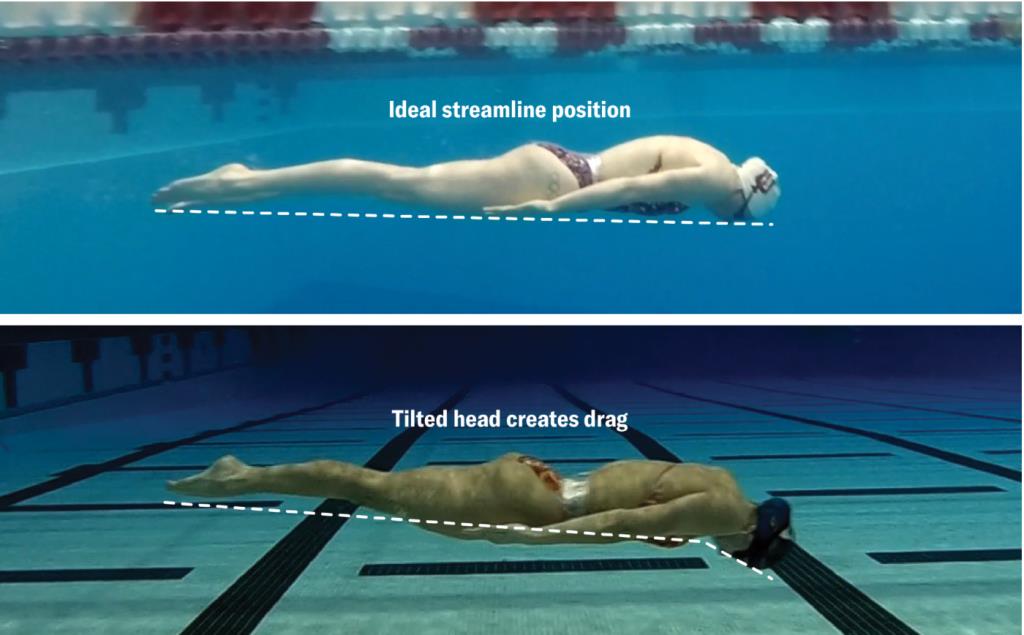
Ken Ono images depicting digital twin technology – comparing Olympic gold medalist Lilly King with another swimmer. (Image Credit: scientificamerican.com)
Another thing to watch is the U.S. team’s use of digital twin technology‘, which evaluates and improves race performance. Ken Ono, a mathematics professor from the University of Virginia (UVA) and his team of students, created digital twins of swimmers and worked with U.S. swim team members, August Lamb and Kate Douglass, to test them ahead of the Paris Games. The digital versions accurately replicate a swimmer’s movements and offer valuable insights to coaches providing information on drag force, a critical factor affecting a swimmer’s performance. The technology allows athletes to make adjustments to their technique, based on the data provided. By virtually experimenting with an athlete’s digital doppelgänger, they can easily run different race scenarios to determine that swimmer’s optimal race plan, their “formula” for success.
Devices, AI Tools & IoT
At the 2014 Sochi Winter Olympics, smart clothing debuted. Canadian company Hexoskin worked with gold and silver medalist freestyle skiers to create Wearable Bluetooth vests that tracked vital signs like heart rate, breathing and VO2 max (how much oxygen your body uses while exercising) to better monitor an athletes’ physiological state and to improve their performance.
By 2024, wearable devices now include armbands and biometric sensors that are devoted to providing real-time data for analyzing the physical situation of athletes’ heart rate, muscle activation, and level of fatigue which empower the athletes and their coaches to develop their training programs more efficiently. In addition, motion capture systems and AI-driven analysis provide detailed insights into technique and form, helping athletes fine-tune their abilities to reach optimal performance.
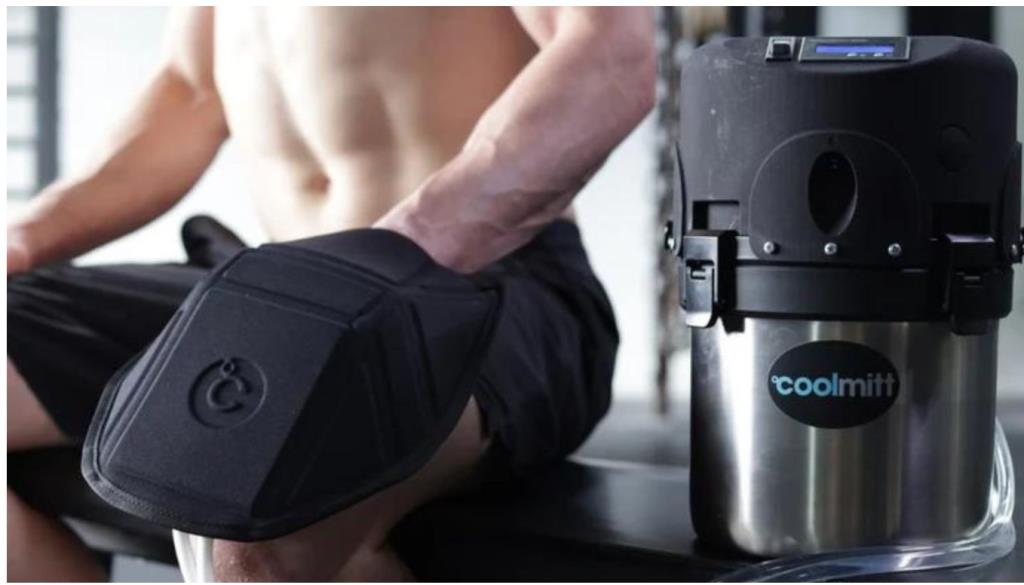
Cool Mitt Technology (Image Credit: IoTWorldToday.com)
With warmer-than-average summer temperatures, competing athletes will face yet another challenge, heat. To combat the heat, some Olympians are turning to a mitten-like device designed to keep them cool during competition. Designed by Stanford University biologists Craig Heller and Dennis Grahn, the CoolMitt is a portable cooling product that offers the wearer a smart way to cool down for up to eight hours on a single charge. Athletes place their hands on the water-filled pad inside the mitt, which is kept at a cool 50 to 53 degrees Fahrenheit. CoolMitt’s vasocooling technology circulates cooler blood back to the athlete’s heart and muscles.
Techno Apparel, Algorithms, AI & Big Data
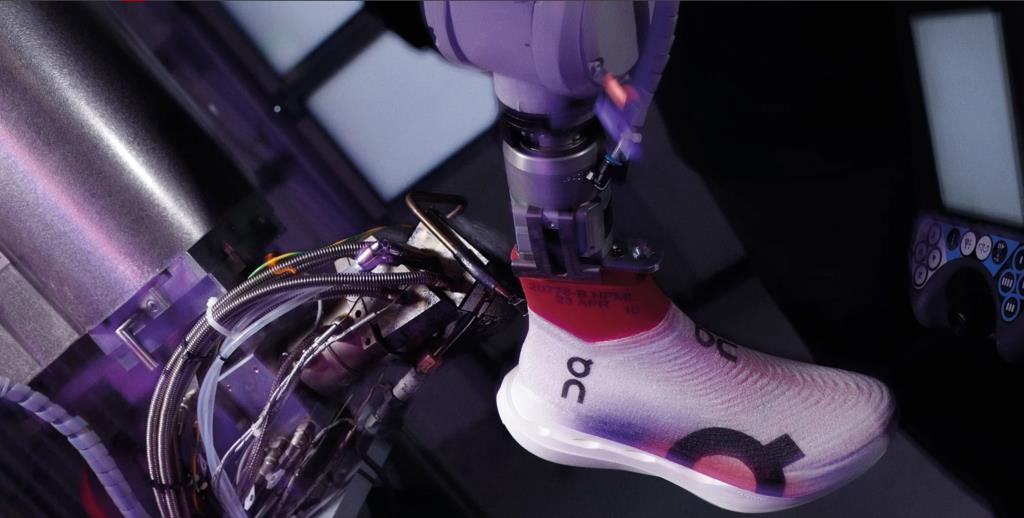
Swiss sportswear brand On and their “revolutionary” spray on robot-made sneaker (Image Courtesy: CNN.com)
In the past, smart shoes were designed to track and analyze movement patterns by cutting the potential risk of an Achilles heel and advising the athlete on their threshold for motion and exertion. Fast forward to 2024, Nike and Adidas unveiled their new trainers with their latest tech. Nike Alphafly 3 ($300) weighing 198 grams, is an updated version of marathon winner Eliud Kipchoge’s record-breaking pair which now have a wider plate and more cushioning. While the Adizero Adios Pro Evo 1 ($500) weighing 138 grams, is 40 per cent lighter than any other shoe Adidas has ever created.
But what’s really getting all the buzz is Swiss sportswear brand On, the latest company to embrace an advanced “spray-on” material, they call LightSpray. It’s a “revolutionary” spray on robot-made sneaker designed to be more adaptable, dynamic and supportive than your average running sneakers. The $330 shoes will be worn by Olympic silver medalist Helen Obiri at the Paris 2024 Games. In addition to be lighter than any other running shoe, the company claims its technology reduces the carbon emissions of producing a shoe’s upper by 75%, compared to other sneaker models. Therefore making a big move towards a more sustainable, circular future.
Big data analytics platforms analyze huge quantities of information from a wide array of sources such as wearable tech, cameras, and sensors that provide a detailed overview of athlete performance. And by using algorithms within AI machine learning architecture, coaches and athletes can use these insights to build strategies on ways to improve performance.
For example, cutting-edge technology created by Swiss watchmaker Omega, the official timekeeper of the Olympic Games since 1932, include AI-driven computer vision cameras specially designed to focus on starting blocks for runners who have built-in sensors that measure an athlete’s force against the footrest at 4,000 times per second. The integrated sensors feed the data to an on-site computer, informing race officials of potential false starts by up to a tenth of a second. The Internet of Things!
SUSTAINABILITY
Ralph Lauren’s CLARUS 100% Recycled Cotton Polo shirts for Team USA (Image Credit: ralphlauren.com)
Team USA – Ralph Lauren utilized CLARUS® technology, patented by Natural Fiber Welding, (NFW), for their polo shirts ($198), a process that lengthens and strengthens recycled fibers using green chemistry. The process transforms cotton fibers into a breathable, high-performance fabric with moisture management and quick-drying attributes similar to plastic-based synthetic fabrics like polyester and nylon.
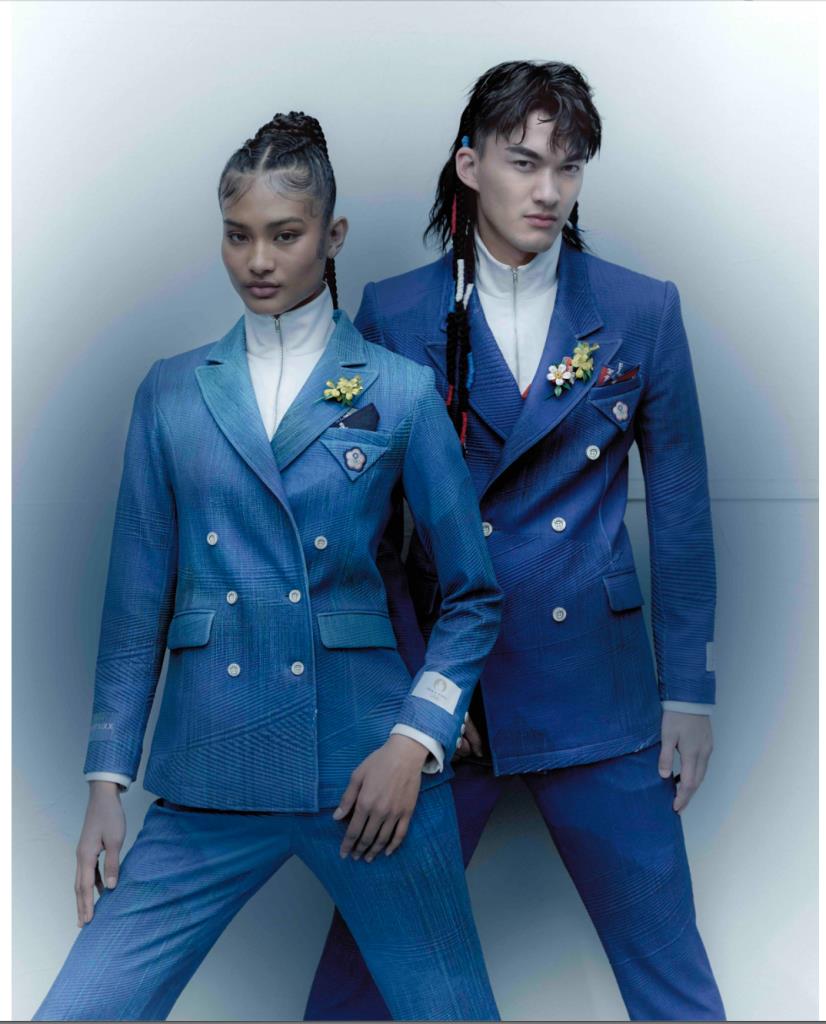
Chinese Taipei’s opening ceremony outfits made with award-winning carbon-captured polyester. (Courtesy of Just In XX)
Team Chinese Taipei (Taiwan) – In a collaboration between material producer Far Eastern New Century (FENC), fabric producer New Wide, and label producer Junmay this team’s uniforms (designed by Justin Yu Ying Chou of JUST IN XX), were made from carbon-captured polyester. FENC created a proprietary biotechnology that captures and reuses carbon emissions. Carbon waste gas is then converted into ethanol, then ethylene glycol, to be combined with petroleum-derived terephthalic acid to form low-carbon polyester. New Wide utilized advanced Nano-Ge Nylon cooling yarn and a single-sided mini loop structure to develop fabric for the official uniform’s polo shirt. Technology = Sustainability!
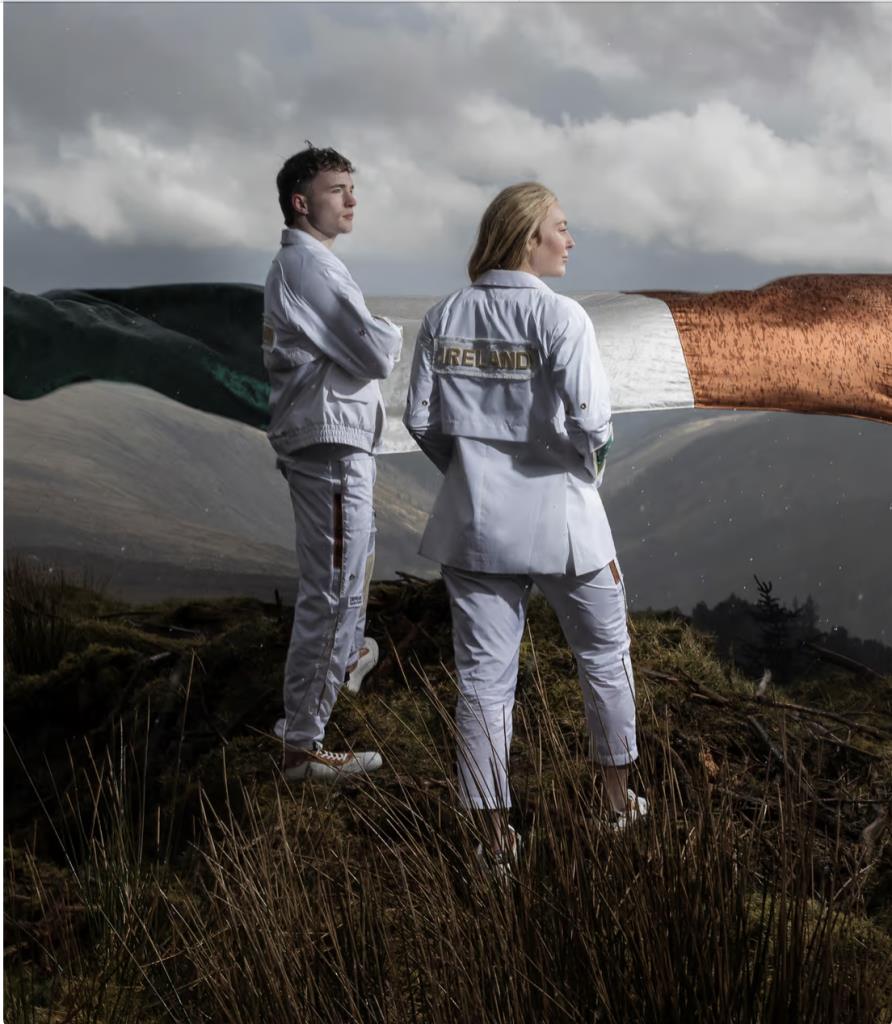
LW Pearl by Laura Weber for Team Ireland Paris 2024 Olympics Credits: LW Pearl by Laura Weber photography by Matthew Thompson
Team Ireland – The suit worn by this team was created and manufactured by Dublin-born, New York-based designer Laura Weber. It is made from ECO-Hybrid taffeta (a fabric used in luxury clothing), a sustainable material made from recycled T-shirts and PET bottles and patented by Japanese company Teijin Frontier. The fabric is lightweight, keeps athletes cool in the summer heat, is water-wicking, and moisture-permeable.
Before the digital era, training was largely driven by the experiences of older gymnasts and coaches. Things have changed. Many countries have ‘sports science teams’ that use VR goggles to assist athletes and AI-powered big-data platforms to capture athletes’ motions, all designed to create winning strategies and outcomes.
Techno Couture
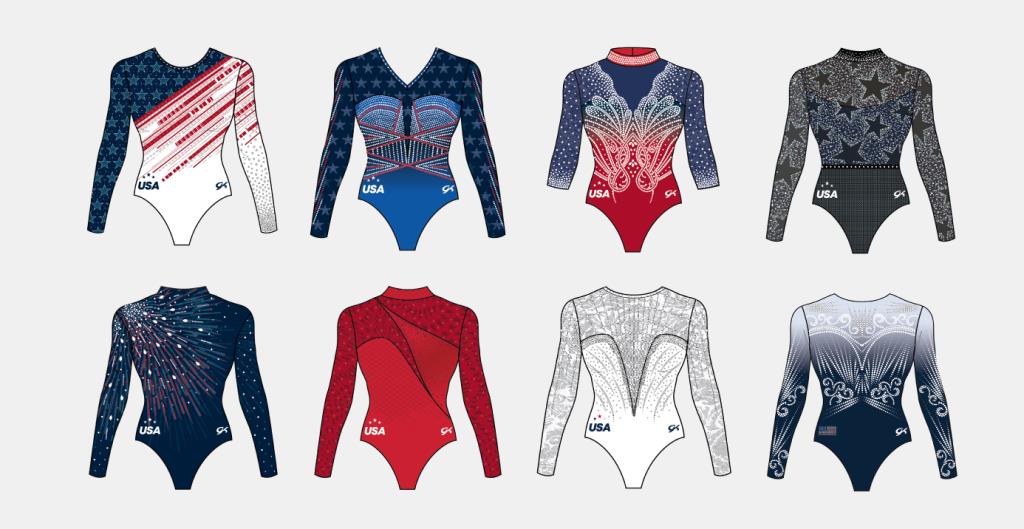
Digital renderings of the eight designs created by GK Elite for the U.S. Gymnastics Team. (Image Credit: Washingtonpost.com)
Two years and the use of technology resulted in eight leotards created for the U.S. Gymnastics Team by leotard company GK Elite. Each gymnast’s set of eight competitive leotards include more than 47,000 crystals and were created using a zero waste cutting technique, the sublimation process (whereby designs are printed onto sheets of paper and heat-transferred onto the fabric), and a rhinestone-transfer machine that individually places crystals onto the heat-transfer paper. The leotards and glued together and then sewn. Some crystals are applied individually with their placements guided by a laser along necklines and near seams. Other crystals are hand-placed with tweezers. These leopards are not available to the public, but the estimated retail cost of each is about $3,000.
More Olympics Fun Facts:
Did you know that past Olympic designers included: André Courrèges, Issey Miyake, Eiko Ishioka, Stella McCartney and Christian Louboutin?
The youngest athlete in Summer Olympic history was Dimitrios Loundras, a male gymnast from Greece, who was 10 years old when he won a bronze medal in the 1896 Athens Olympics.
The oldest athlete was Sweden’s Oscar Swahn, who at 72, competed in shooting at the 1920 Antwerp Games.
Care to share any other fun facts you may know about Olympic fashion?
-------------------------------------
By: Francesca Sterlacci
Title: Paris Olympics 2024 Fashion: Technology & Sustainability
Sourced From: www.universityoffashion.com/blog/paris-olympics-2024-fashion-technology-sustainability/
Published Date: Sat, 03 Aug 2024 21:35:19 +0000
Read More
 FestivalsMusicNew ReleasesArtistsFashion & ClothingVideosPrivacy PolicyTerms And Conditions
FestivalsMusicNew ReleasesArtistsFashion & ClothingVideosPrivacy PolicyTerms And Conditions
